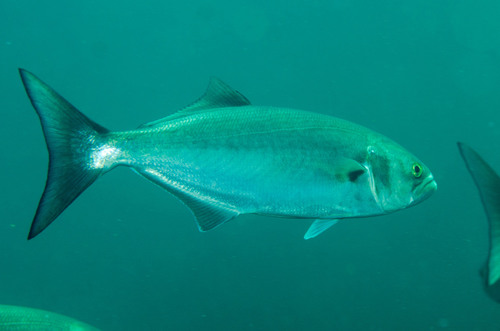
Bluefish
The Atlantic bluefin tuna (Thunnus thynnus) is a highly migratory, predatory fish renowned for its size, speed, and commercial value. It is a crucial part of marine ecosystems and plays a significant role in the cultures and economies of many regions. This species faces considerable conservation challenges due to its high demand.
7 9 years
Lifespan
120 cm
Length
Vulnerable
Conservation Status
40 km/h
Swimming speed
Carnivorous
Diet
Seasonal Migration
Migration
Appearance Overview
The Atlantic bluefin tuna is a large, streamlined fish with a metallic blue-black back and a silvery-white belly.
Coloration
Dark metallic blue on top, silvery-white underside
Body Shape
Torpedo-shaped, streamlined
Fins
Two dorsal fins, the first is yellowish or bluish, the second is reddish-brown
Finlets
Small, yellow finlets running from the second dorsal and anal fins to the tail
Length
Up to 13 feet (4 meters)
Weight
Up to 2,000 lbs (907 kg)
Diet
Carnivorous, feeding on a variety of fish, squid, eels, and crustaceans.
Feeding Behavior
Aggressive predator that uses its speed and agility to hunt, often hunting cooperatively in schools to corral and capture prey.
Social Behavior
Highly migratory, forming large schools, especially during spawning season. Schools can sometimes include thousands of individuals.
Commercial Relevance
Extremely high value, especially in sushi and sashimi markets, where a single fish can fetch hundreds of thousands of dollars.
Conservation measures
Subject to international fishing quotas and regulations managed by organizations like ICCAT. Marine protected areas and fishing gear restrictions also play a role.
Status
Endangered (Varies by population segment; some are considered critically endangered)
Threats
Overfishing (historically and ongoing), bycatch in fishing gear, climate change affecting prey distribution and spawning grounds.
Habitat Distribution
Depth Range
0-1,000 meters (0-3,280 feet), but typically found in epipelagic and mesopelagic zones.
Geographic Range
Atlantic Ocean, Mediterranean Sea, and formerly the Black Sea.
Preferred Environment
Temperate and subtropical waters; highly migratory, following prey and specific water temperatures.
Reproduction and Life Cycle
Breeding Habits
Spawns in specific areas like the Mediterranean Sea and the Gulf of Mexico, with spawning occurring in warmer waters during specific times of the year.
Development Stages
Eggs hatch into larvae, which develop rapidly, feeding on plankton. Juveniles grow quickly, eventually reaching maturity.
Fecundity
Females are highly fecund, capable of releasing millions of eggs (up to 30 million) per spawning season.
Maturity Age
Maturity varies by location, but generally between 4-8 years.
Faqs about Bluefish
How long do Atlantic bluefin tuna live?
Atlantic bluefin tuna can live up to 40 years.
How fast can bluefin tuna swim?
They are among the fastest fish in the ocean, capable of bursts of speed up to 43 mph (70 km/h).
Are bluefin tuna warm-blooded?
Yes, they are warm-blooded, which allows them to maintain a higher body temperature than the surrounding water, aiding in muscle efficiency and speed.
Where are Atlantic Bluefin Tuna Found?
Atlantic bluefin tuna are primarily found in the Atlantic Ocean, ranging from the cold waters of the North Atlantic to the warm tropical waters of the Gulf of Mexico and the Mediterranean Sea.
What Eats Atlantic Bluefin Tuna?
Atlantic bluefin tuna are apex predators, meaning they are at the top of the food chain and have few natural predators. Young tuna may be preyed upon by larger fish and sharks, but adults have very few natural enemies other than humans.
Copyright @ Nature Style Limited. All Rights Reserved.
 English
English